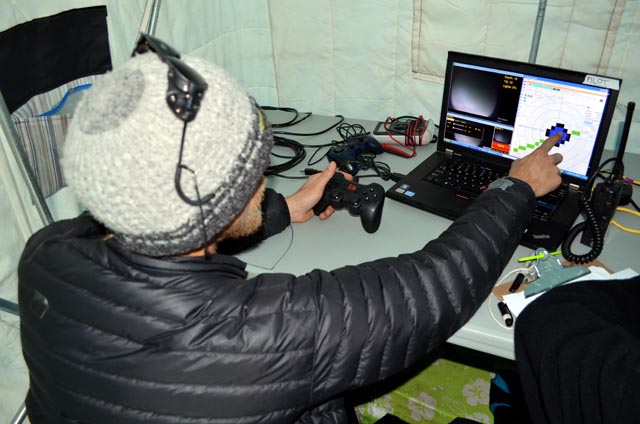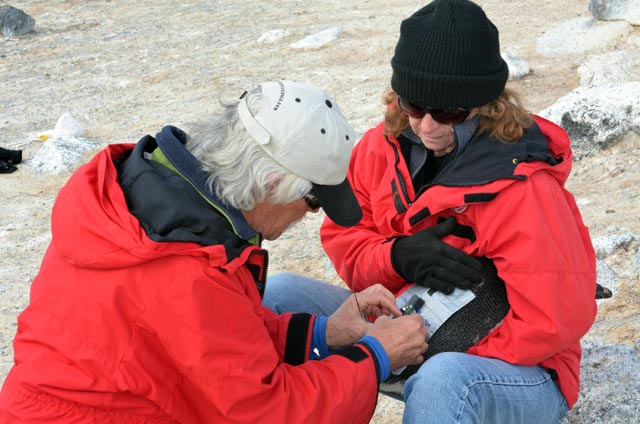|
Page 2/3 - Posted May 24, 2013
Icebreaker crashes plan to use channel for researchEvery year an icebreaker arrives at ice-covered McMurdo Sound. Its job is to break a channel through about 30 kilometers or so of sea ice to reach McMurdo Station and escort cargo and fuel vessels into the small harbor. It doesn’t take long before whales and penguins follow in its wake. In effect, the icebreaker abruptly allows access to new hunting grounds. The research team has aimed to collect a suite of data about the targeted prey species, as well as phytoplankton and sea ice biota, such as abundance and distribution. The controlled experiment is designed to take snapshots of the food web before, during and after the icebreaker does its work. That should offer insight on how the predators affect prey dynamics. Ainley’s group in the past has observed that the penguins are forced to make longer foraging trips and dive deeper after the whales have arrived. The biologists wonder if all these predators have chased prey to deeper depths or actually depleted their abundance, making it more difficult for penguins. “There’s a difference between simply observing what’s going on and putting together all of the pieces so they make sense, and actually doing some sort of manipulative experiment so that you test a hypothesis,” Kim explains. Unfortunately, in Antarctica, even the best laid plans can go awry. In this case, it wasn’t Mother Nature but ship schedules. The Russian icebreaker Vladimir Ignatyuk Plan B: Use the ice edge as a proxy, or substitute, for the ice channel. Kim and the rest of the SCINI team eventually explored, over the course of the austral summer, a large swath of McMurdo Sound by sending SCINI and FATTI under the sea ice through holes drilled by a gas-powered auger. The robot and its instrument package made a series of transects away from the ice edge, where the whales and penguins congregate. SCINI and FATTI collected data in areas where the deep-diving animals could and couldn’t reach based on their physiology. The scientists timed their forays around the phytoplankton bloom, when the water turns bluish-green — a phenomenon big enough to see from space. The fieldwork involved long days on snow machines to reach transect sites. A tent was set up for SCINI’s command center — a couple of laptops and a PlayStation game controller that is used to pilot the robot. Several hundred meters of communication and power cable were spooled and unspooled as the ROV cruises the waters looking for krill and fish. 
Photo Credit: Peter Rejcek
Engineer Laughlin Barker pilots SCINI using a PlayStation game controller and laptop.
“We’re controlling SCINI a little bit differently than if we didn’t have anything attached. It’s kind of like pulling a trailer,” notes Barker, as he pilots the instrument through the sub-freezing waters of McMurdo Sound from inside the small pop-up tent with Heather Broadbent Daly, co-principal investigator on the project, and her lab team are the krill experts. They’re also helping collect physical oceanographic data — temperature and salinity — to measure how melting ice might relate to prey distribution. “There’s a pretty huge melt signal,” notes Benjamin Saenz, now at the University of Colorado in Boulder “I want to know what drives the krill to be where they are,” Saenz says, later echoing Ainley’s comments: “We don’t know much about crystal krill.” It’s no mystery about what drives the whales to the ice edge: food. But what exactly these large animals are feasting upon is less clear. For at least one species of killer whale, it’s almost certainly fish of some kind. The killer whales that roam the Ross Sea are primarily a species referred to as Type C, the smallest of at least three different kinds of Antarctic killer whales that Pitman, Durban and colleagues identified in a series of papers. The larger ones are called Type A and Type B. Type C killer whales, called Ross Sea killer whales by Pitman, have been observed feeding on Antarctic toothfish, a large, long-lived fish that like many of its brethren has special adaptations that allow it to survive in the sub-freezing waters, including a sort of anti-freeze in its blood. Large toothfish also are very fat, which is why killer whales and seals are interested in eating them. How much Antarctic toothfish account for the killer whale diet is a mystery. Pitman says the silverfish make up about 95 percent of fish biomass in the Ross Sea. Each killer whale requires about 75 kilograms of food per day. That would be a lot of silverfish or just a couple of Antarctic toothfish. “They’re basic option is they can take a few big fish or they can take an almost unlimited quantity of the little fish,” Pitman notes. “We know they take the big fish sometimes — and that’s all we know.” |



For USAP Participants |
For The Public |
For Researchers and EducatorsContact UsU.S. National Science FoundationOffice of Polar Programs Geosciences Directorate 2415 Eisenhower Avenue, Suite W7100 Alexandria, VA 22314 Sign up for the NSF Office of Polar Programs newsletter and events. Feedback Form |



